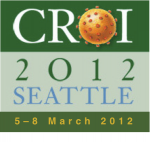Renal impairment in the D:A:D study
1 June 2012. Related: Conference reports, Antiretrovirals, Coinfections and complications, CROI 19 (Retrovirus) 2012.
 Simon Collins, HIV i-Base
Simon Collins, HIV i-Base
An analysis from the large prospective D:A:D cohort looked at patients with normal renal function at baseline and associations between renal changes and individual HIV drugs and changes in treatment, adjusting for renal and HIV related risk factors.
This included >22,600 patients who started ART from 2004 with eGFR >90 mL/min. Progression of renal dysfunction was defined as eGFR decline to <70 (the threshold for proactive switches away from individual ARVs with a concern for renal toxicity), confirmed eGFR <60 mL/min.
During a median follow-up of 4.5 years (IQR 2.7-6.1), approximately 2.1% patients (n=468) progressed to confirmed eGFR <70 and 0.6% (n=131) to chronic kidney disease (CKD) with incidence rates (IR; 95%CI per 1000 PY) of 4.78 (4.35 to 5.22) and 1.33 (1.10 to 1.56), respectively.
In people with reduced eGFR, tenofovir was the only ARV that was actively switched (at eGFR 60-70 vs >90) with an adjusted IR ratio 1.72 (95%CI 1.38 to 2.14). This was interpreted as being due to the general awareness of tenofovir and renal complications.
Cumulative use of tenofovir and atazanavir/ritonavir were independently associated with increased rates of confirmed eGFR =70, but not CKD. Lopinavir/ritonavir (Kaletra) was also associated with both increased risk for renal endpoints and abacavir was associated only with higher rates of CKD. See Table 1.
| ARV | confirmed eGFR <70 IRR (95%CI) |
p-value |
CKD |
p-value |
|---|---|---|---|---|
| tenofovir | 1.18 (1.12-1.25) | <0.0001 | 1.08 (0.97-1.21) | 0.16 |
| abacavir | 1.04 (0.99-1.09) | 0.061 | 1.08 (1.00-1.17) | 0.046 |
| atazanavir/r | 1.20 (1.09-1.32) | 0.0002 | 1.16 (0.95-1.42) | 0.15 |
| atazanavir | 1.10 (0.92-1.33) | 0.29 | 0.80 (0.45-1.43) | 0.45 |
| lopinavir/r | 1.11 (1.05-1.17) | 0.0002 | 1.24 (1.13-1.36) | <0.0001 |
| other PI/r | 1.03 (0.95-1.11) | 0.52 | 1.11 (0.97-1.26) | 0.13 |
The relationships to use of tenofovir, atazanavir/r and lopinavir/r were with current use, whereas >1 year after drug discontinuation the rates approached 1.0. Other predictors (adjusted IRR; 95%CI) of confirmed eGFR =70 were age (2.63 per 10 years: 2.33 to 2.96), diabetes (1.54; 1.06 to 2.23), hepatitis B virus (1.56; 1.10 to 2.22), hepatitis C virus (1.47; 1.09 to 2.00), current CD4 count (0.75 per doubling; 0.69 to 0.82) and prior AIDS (1.38; 1.13 to 1.69).
comment
Although the study concluded that these rates were generally low, it also highlighted that compared to lifetime use of ART, follow-up may be too short to pick up such dramatic declines in renal function, especially if rates continue or increase with age. Nevertheless, over five years, incidence of progression of eGFR from >90 to <70 were twice as high in patients who used tenofovir (vs never used).
The study suggested that proactive switching from tenofovir was protective after one year and that closer monitoring of renal function may be appropriate for people using atazanavir/r or lopinavir/r.
See also the recent publication in AIDS of the VA cohort analysis of tenofovir and renal function, reported later in this issue of HTB.
Reference:
Ryom L et al for the D:A:D Study Group. Exposure to ARV and the risk of renal impairment among HIV+ persons with normal baseline renal function: the D:A:D study. 19th CROI, 5-8 March 2012, Seattle. Poster abstract 865.
http://www.retroconference.org/2012b/Abstracts/45437.htm
http://www.retroconference.org/2012b/PDFs/865.pdf

